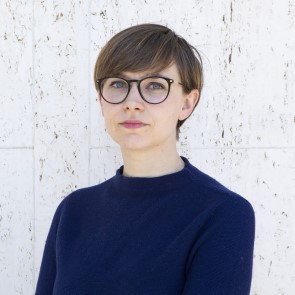
"Memories of the Resistance: Margarete Schütte-Lihotzky and the Architecture of Collective Dissidence, 1918–1989"
Professional Background
Dr. S.E. Eisterer (f.k.a. Sophie Hochhäusl) is an assistant professor of architectural history and theory at Princeton University’s School of Architecture. She received her PhD and MA from Cornell University, as well as an MArch from the Academy of Fine Arts, Vienna (Austria). Before coming to the Museum, she was the Frieda L. Miller Fellow at the Radcliffe Institute for Advanced Study at Harvard University (2017-2018), a Princeton-Mellon Fellow in Architecture, Urbanism, and the Humanities (2020-2021), and a Humboldt Fellow at the Technical University Darmstadt and the Munich Documentation Centre for the History of National Socialism. She has also taught at Boston University and the University of Pennsylvania.
Dr. Eisterer studies modern architecture and urban culture with a focus on spatial histories of exile, resistance, gender, and histories of social movements. Her recent essays and articles have concentrated on left-leaning organizations, designers, artists, and intellectuals whose creative work can be characterized as resistance art. Dr. Eisterer's first book, Otto Neurath–City Planning, explored the graphic design efforts of the Austrian economist, sociologist, and philosopher Otto Neurath, who spearheaded equitable forms of planning in collaboration with housing associations. Currently Dr. Eisterer is working on two book projects: the interdisciplinary history and translation project Memories of the Resistance: Margarete Schütte-Lihotzky and the Architecture of Collective Dissidence, 1918–1989 (translated by Dr. Raphael Koenig), as well as the monograph, Housing Cooperative: Politics, Architecture, and Urban Imagination in Vienna, 1904–1934. Her articles on spatial histories of dissidence have been included in Architectural Histories, Architecture Beyond Europe, Aggregate, the Chilean journal Ediciones ARQ, as well as Log and Platform. She was chosen to deliver the Detlef Mertins Memorial Lecture on the History of Modernity at Columbia University in 2020. At the University of Pennsylvania, Dr. Eisterer was a member of the program in Gender, Sexuality, and Women’s Studies. She is also a participant in the Insurgent Domesticities Group at the Center for the Study of Social Difference at Columbia University.
Fellowship Research
Dr. Eisterer was awarded a 2020-2021 Resnick Postdoctoral Fellowship for her second book project, Memories of the Resistance: Margarete Schütte-Lihotzky and the Architecture of Collective Dissidence, 1918–1989. Today the Austrian architect Margarete Schütte-Lihotzky (1897–2000) is widely recognized as one of the most significant female figures in interwar design. Her participation in the communist resistance against the Nazi regime and her lifelong efforts as an anti-fascist activist, however, have been entirely ignored by historians in the English-speaking world. The German-language autobiography, Erinnerungen aus dem Widerstand: Das Kämpferische Leben einer Architektin, 1938–1945 (Memories of the Resistance: The Defiant Life of a Female Architect, 1938–1945), is a major work chronicling women in the resistance. Published in 1984, it has not yet been translated into English.
Memories of the Resistance: Margarete Schütte-Lihotzky and the Architecture of Collective Dissidence, 1919–1989, explores Schütte-Lihotzky’s architectural and activist work and analyzes the international networks of dissidents with whom she collaborated between 1938 and 1945 in Vienna, Zagreb, Paris, Moscow, Tel Aviv, Istanbul, and New York. Among other groups, the book focuses on Jewish refugee organizations and the editorial spaces of anti-fascist newspapers such as Nouvelle D’Autriche and The Austro-American Tribune. Although the book loosely follows Schütte-Lihotzky’s life, it is not merely a critical biography of an individual; rather, it highlights the work of groups and collectives that were strengthened—and at times fractured—by their political and artistic objectives in dissident work. Emphasizing the challenges that Holocaust survivors continued to confront in the postwar years, the book is also a reflection about the spatial politics of memorials and the culture of forgetting in Austria. Including a scholarly monograph, the first complete English translation of Schütte-Lihotzky’s memoir, and translations of letters with annotations written from internment, this book is a resource for scholars concerned with the intersection of architectural history, memory studies, and women in the resistance.
